The Yougtimers of the 70s and 80s: between turbo and carburetor
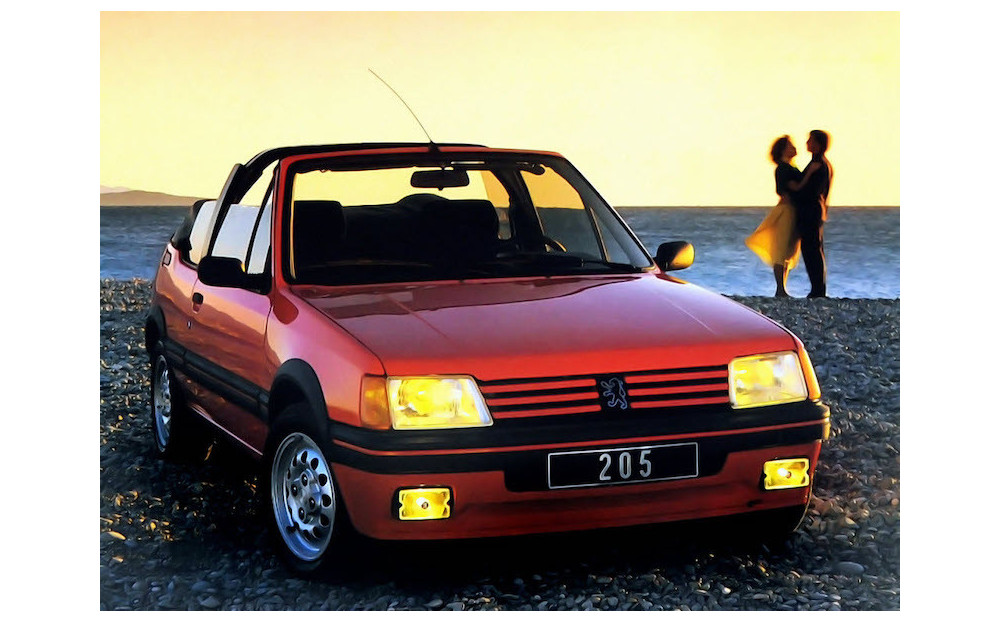
Discover on our blog the Youngtimers of the 1970s and 1980s.
From the Citroën Visa Chrono to the Peugeot 205 GTI via the Supercinq GT Turbo and the more traditional Peugeot 505 and Renault 9, discover the classic models of French manufacturers that have become Youngtimers in recent years.
Citroën: classicism proves its worth
Citroën Visa (1978 -1988): an inimitable and inimite style.*
With the Visa, Citroën replaced the Ami 8 in 1978. Available only in 5 doors and positioned halfway between a city car and a compact with its length of 3.69m. If it is a little shunned by collectors, some versions deserve attention.
The most popular versions in the World of Youngtimers are the Visa Chrono and the Visa GTI. With its 4-cylinder, 1360 cm3, topped with two Solex double-body carburetors, the Visa Chrono, which weighs only 850 Kg, sees its power increased to 93 horsepower. The 0 to 100 km/h is achieved in just over 10 seconds.
It will be replaced in 1984 by the GTI version. It borrows the injection engine of its new cousin, the Peugeot 205 GTI. Its 1580 cm3 XU block receives Bosch Jetronic electronic injection. The power reaches 105 horsepower then 115 horsepower, following the evolutions of its cousin Peugeot. With its light weight, the Visa goes under the 9-second mark to reach 100 km/h.
A discoverable version was also offered by the brand in partnership with the great French coachbuilder of the time, Heuliez. Without being a real convertible because of its door jambs and the side parts of the original roof preserved, it offers a canvas sunroof going all the way to the tailgate. A rather rare model, only 2600 copies were marketed between 1983 and 1985.
The 3 most interesting versions of Citroën Visa to collect:
· Visa Chrono,
· GTI Visa,
· Convertible Visa.
Peugeot: a perpetual evolution to offer more and more
Peugeot 104 (1972-1988): The city car with a long journey
Launched in 1972, the new Peugeot 104 is a city car offered in 3-door coupe and 5-door versions. This model is emblematic of an entire era for the Peugeot-Citroën group. It will serve as a common base for the Citroën LNA and Citroën Visa as well as the Talbot Samba. It is also the result of the collaboration between Peugeot and Renault, which will give birth to the Renault 14.
If the 5-door version is quite banal, the 3-door coupe version, shorter by 28 cm, was declined in several interesting versions. Over the years and until the end of its production in 1988, the Peugeot 104 will be restyled several times.
On the sedan side, the version to remember is the Peugeot 104 S which offers from 1979, an engine of 1,124 cm3 developing 66 horsepower. The following year, the S and the ZS coupe received a new 1360 cm3 engine with 72 horsepower and which would later evolve to 80 horsepower. With a very light weight, the Peugeot 104 coupe is an agile and fun car to drive. The five-speed gearbox appeared in 1983.
The 3 most interesting versions of Peugeot 104 to collect:
· Peugeot 104 ZS2,
· Peugeot 104 S,
· Peugeot 104 ZS.
Peugeot 305 (1977-1988): a typical line of the 70s and 80s for the small Sochalian sedan
In the classics of Peugeot, there is the shy Peugeot 305. Launched in 1977 and renewed in 1982, the Peugeot 305 is a wagon offered in sedan and estate bodywork from which a van version, very rare now, is derived from it.
Rather light and with a healthy road behavior, the 305 is the wagon par excellence. Its reasonable price makes it accessible while offering appreciated comfort. However, the engines offered are not very exciting.
Only the S version, based on a 1.5 from the previous generation inflated to 89 horsepower, and the GTX and GT, featuring the new XU9S block with dual-body carburetor and developing 105 horsepower of the Citroën BX 19 GT offer honest performance.
The 3 most interesting versions of Peugeot 305 to collect:
· Peugeot 305 S,
· Peugeot 305 GTX (with leather option),
· Peugeot 305 Van.
Peugeot 505 (1979-1992): the french luxury road car
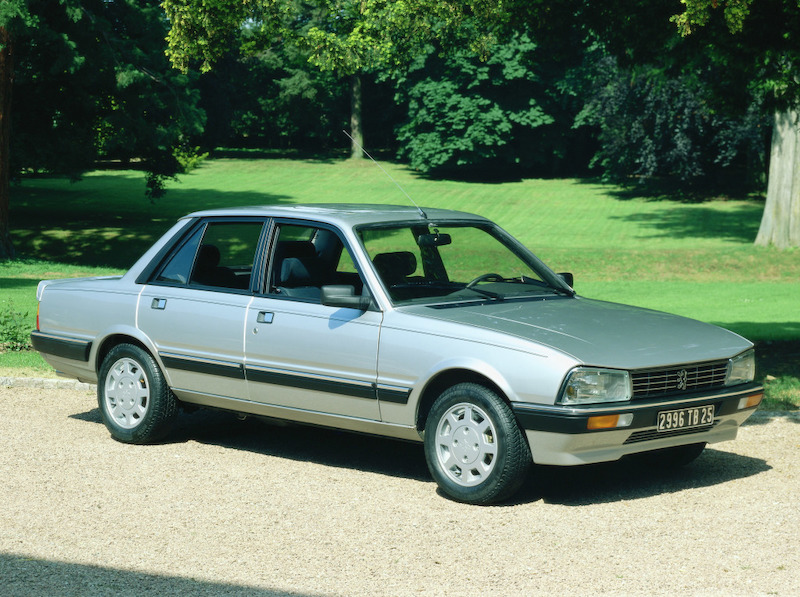
With the Peugeot 505, the Sochalian manufacturer is evolving its style. If the brand's large road car retains a three-body body with a rear trunk, the line is neat. It is the work of Pininfarina who will sign other successful bodies for the brand in the following years. A true high-end car, the equipment will be rich and will expand over the years. In 1986, the 505 V6 already had ABS and 4 electric windows as standard as well as cruise control.
The Peugeot 505 is the last rear-wheel drive car of the French manufacturer. She is known for not fearing big mileage. It will be available in a Break version which will be very popular with paramedics, but also with large families with the 8-seater Family version.
The version receiving a two-tone paint is none other than the Turbo Injection. Based on a 2.2 engine, initially 150 horsepower then 160 horsepower thanks to the addition of an air exchanger, the latter will be able to receive a PTS kit (Peugeot Talbot Sport) that will increase the power to 200 horsepower and will even be homologated for the road. A 2.8 V6 version developing 180 horsepower will also be in the catalog from 1986.
The 3 most interesting versions of Peugeot 505 to collect:
· 505 TSI,
· 505 Turbo Injection PTS 200 hp,
· 505 V6.
Peugeot 309 (1985-1994): boldness in the cylinder head
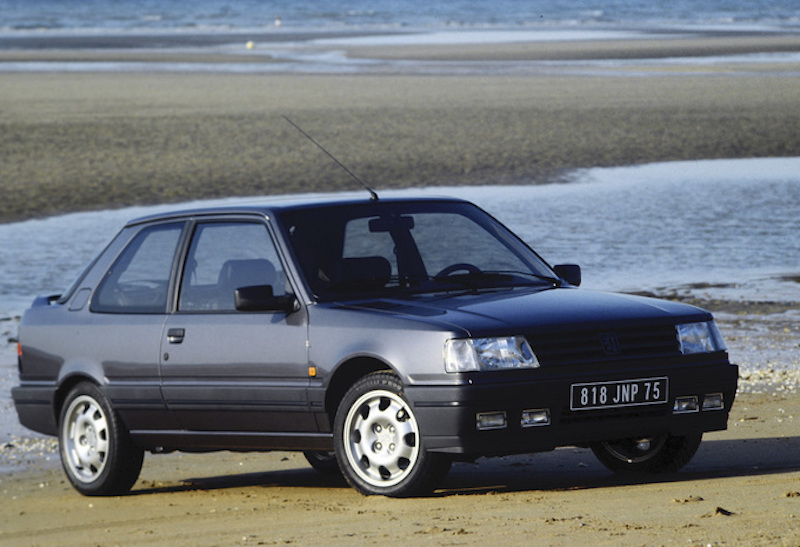
With the Peugeot 309, the three-body line for the compact sedan is abandoned. The new compact features a modern two-body line. At its launch in 1985, a nice GT version was offered. It takes over the 1.9 engine of 105 horsepower appeared on the 305 GT / GTX and the Citroën BX 19GT.
It will be replaced 2 years later by the injection version, inherited from the Peugeot 205 GTI, the block develops 130 horsepower. The 309 GTI was born. It is available in 3 and 5 doors. During its career, it will be renewed with a phase 2 appeared for the 1990 vintage.
The stylistic evolution will include a new grille with a 205 look and a redesigned rear face. It will also be an opportunity to see the catalog evolve with the arrival of the mythical 309 GTI 16 exclusively in 3 doors. Taking over the engine block of its big sister, the Peugeot 405 Mi16, it develops a power of 160 horsepower with its 16-valve cylinder head placed on the XU9 engine of the GTI.
The 3 most interesting versions of Peugeot 309 to collect:
· Peugeot 309 GTI16,
· Peugeot 309 GTI,
· Peugeot 309 GT.
Peugeot 205 (1982-1998): the collector not to be missed with a very rich range
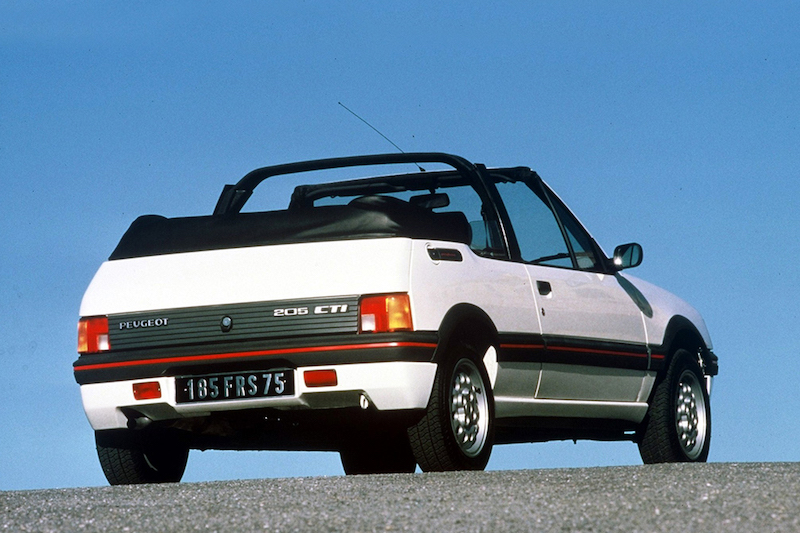
The Peugeot 205 has had a long career of 16 years just like the Peugeot 104 before. It is a huge success for Peugeot which sells more than 5 million in different bodies that have all marked an era, a generation.
The Peugeot 205 is one of the first cars to have launched the Youngtimers movement in France. Many of us have learned to drive with it or owned one after the license. It is also the city car par excellence that our parents used to take us to school and those of the dynamic young executives who are looking for the thrill at the weekend at the wheel of their 205 GTI or with a CTI convertible.
The range is very rich and varied, there is something for everyone. From the simple 205 Junior and its small 954 cm3 engine of 45 horsepower through the entry-level convertible version CJ and the inevitable GTI declined in 1.6 of 105 then 115 horsepower, but also in 1.9 of 130 horsepower then 122 horsepower with the anti-pollution standards that have evolved over the years.
A convertible variant is also born with the sports engine, the CTI at the beginning with the 1.6 of 115 horsepower then in 1.9 of 105 horsepower. The Furious 205 Rallye and its 1.3 engine has its fans as well. Many special series have also joined the range, such as the Roland Garros with their green hue and fragile white leather, the Lacoste and Indiana versions or the GTI-style Griffes with a very high-end finish, but with a deflated GTI engine as on the CTI 1.9.
Everyone will be able to find their happiness in the 205 range. Some have even managed to mount more powerful blocks like the 2.0 Turbo CT borrowed from the 605 and 806. There is also the mythical 205 Turbo 16 version, but its rarity and very high price make it inaccessible.
The 3 most interesting versions of Peugeot 205 to collect:
· Peugeot 205 GTI 1.6 or 1.9,
· Peugeot 205 CTI,
· Peugeot 205 Griffe.
Renault: the latest figures
Renault 4 (1961-1992): Timeless and still very popular
The famous Renault 4L flooded the streets of many countries during its career. Launched in 1962, his career was very long for an automobile, no less than 30 years. The time for it to sell more than 8 million copies.
It will be mainly available in sedan and van F4 and F6. It represents a part of automotive history. A time when electronics or injection was still at the distant prototype stage. What best characterizes the Renault 4 is simplicity.
The 3 most interesting versions of Peugeot 205 to collect:
· Renault 4 F6,
· Renault 4 Parisienne,
· Renault 4 Plein Air.
Renault 5 (1972-1984) and Supercinq (1984-1996): compact, light and powerful
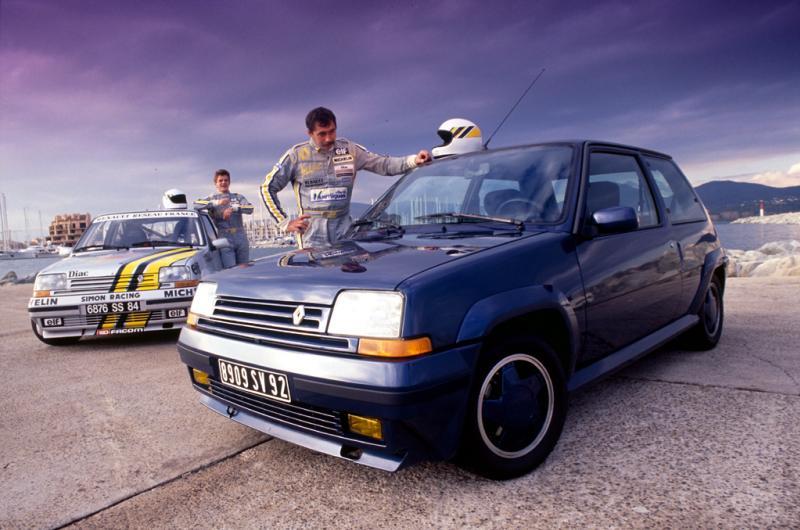
The Renault 5 launched in 1972 will be followed in 1984 by the new generation called Supercinq. Renault has sold more than 8 million of the two versions of its city car. The first generation of Renault 5 has only petrol engines. It was offered in 3 or 5 door bodywork.
In 1976, Renault launched the Renault 5 Alpine sports model with a 1397 cm3 Cléon engine developing 93 horsepower. Its unique style makes it possible to identify it with its sport rims and side stripping. At the end of the year 81, Renault grafted a turbo, the R5 Alpine Turbo was born. It is 110 horsepower strong and its top speed exceeds 185 km/h. In 1984, it became the R5 Lauréate Turbo.
To conquer the world of rallying, Renault launched the Renault 5 Turbo in 1981 with a 1397 cm turbocharged engine. The dashboard is designed by Bertone and offers a radically different look from the classic version of the R5. On the outside the bumpers and sills are painted body color. Then came the Turbo 2 in 1983, whose engine is identical for the production versions. Only the appearance is revised, the bumpers have become gray again.
In 1984, when the R5 became the entry-level economy under the name R5 Lauréate, Renault launched the Supercinq with a much more modern style to compete with the Peugeot 205 which began to become a real success at Peugeot. Renault offers many petrol and diesel versions in 3 and 5 doors.
The most interesting were the Renault 5 Baccarat with their beige leather interior and very high-end finish, available with a 1.4 coupled with an automatic transmission or the 1.7 with 90 horsepower with a 5-speed manual gearbox. For the sporty version, Renault will offer the famous Supercinq GT Turbo, whose power will evolve up to 120 horsepower.
The Super5 GT Turbo will be one of the most capable city cars of an entire generation. If top speed is not his specialty, the acceleration is brutal under the pressure of his Turbo.
The 3 most interesting versions of Renault 5 to collect:
· Renault 5 Alpine Turbo,
· Renault Super 5 GT Turbo Alain Oreille,
· Renault 5 Turbo.
Renault 9 and Renault 11: two-body or three-body? With or without turbo?
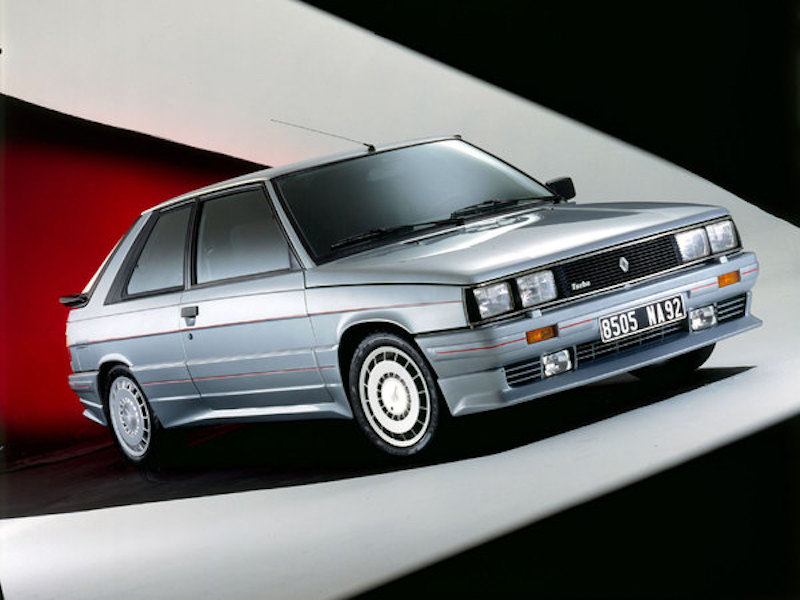
In 1981, Renault launched the R9. It was named Car of the Year in 1982. Yet his line is aging fast. Its roominess is good for the category, but its style is already dated as soon as it is released. Renault offers a GTS version with side stripping and a 1397 cm3 engine with 72 horsepower.
Then will come the Turbo version with its 4-optic grille and 105 horsepower engine in phase 1 then 115 horsepower in phase 2. It becomes rare on our roads and even more so in the Turbo version, which does not lack charm with its revised front end.
To boost its range, Renault launched the Renault 11 in 1983. It takes the style of the R9, but this time with a two-body with a hatchback in 3 and 5 doors. An intriguing TSE Electronic version is offered with a digital dashboard. Then will come the Turbo version of the R11 which shares the same mechanics as the R9 Turbo.
Renault offered in 1985 a limited edition of the Turbo, the R11 Turbo Zender. It receives a specific body kit and a rear axle, with 4 bars, from the Super5 GT Turbo as well as 15" wheels instead of the 14" standard on the Turbo.
The 3 most interesting versions of Renault 9 and Renault 11 to collect:
· Renault 9 Turbo,
· Renault 11 Turbo Zender,
· Renault 11 Electronic.


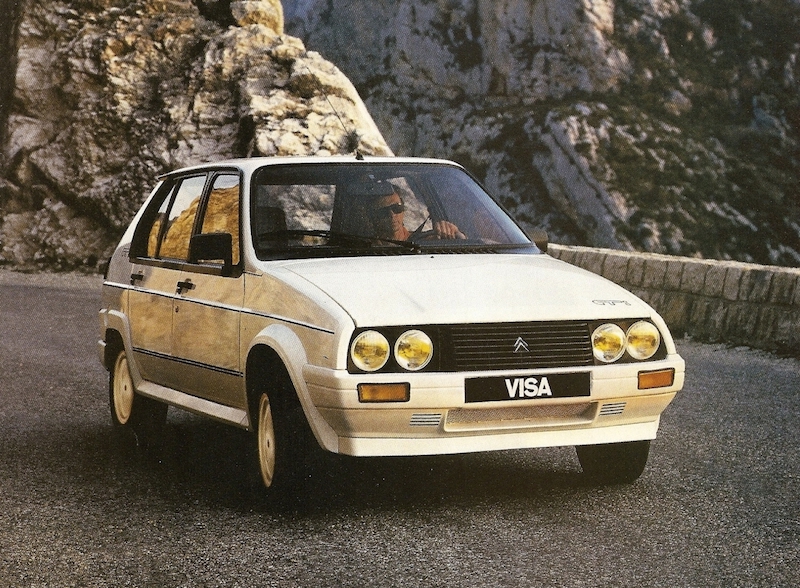
Comments
No comment at this time!
Leave your comment